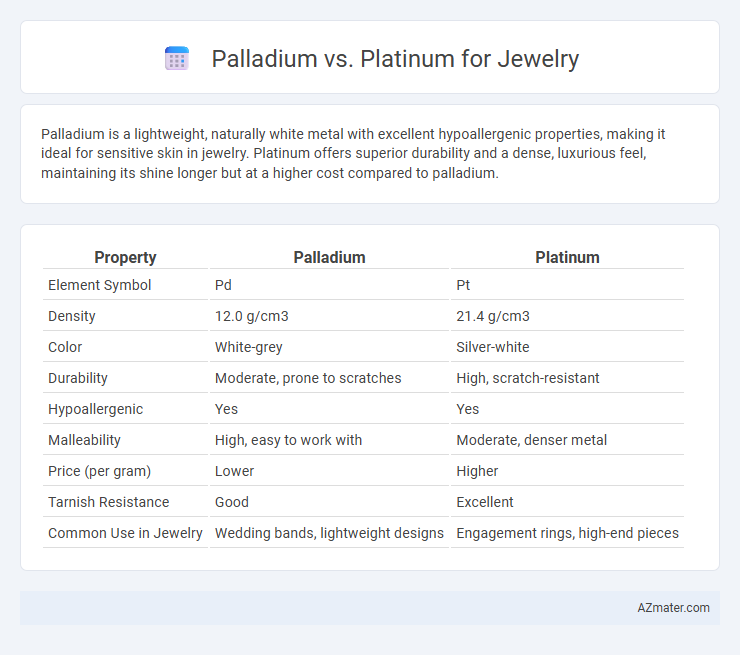Palladium is a lightweight, naturally white metal with excellent hypoallergenic properties, making it ideal for sensitive skin in jewelry. Platinum offers superior durability and a dense, luxurious feel, maintaining its shine longer but at a higher cost compared to palladium.
Table of Comparison
| Property | Palladium | Platinum |
|---|---|---|
| Element Symbol | Pd | Pt |
| Density | 12.0 g/cm3 | 21.4 g/cm3 |
| Color | White-grey | Silver-white |
| Durability | Moderate, prone to scratches | High, scratch-resistant |
| Hypoallergenic | Yes | Yes |
| Malleability | High, easy to work with | Moderate, denser metal |
| Price (per gram) | Lower | Higher |
| Tarnish Resistance | Good | Excellent |
| Common Use in Jewelry | Wedding bands, lightweight designs | Engagement rings, high-end pieces |
Introduction to Palladium and Platinum in Jewelry
Palladium and platinum are both precious metals prized in fine jewelry for their durability and natural white luster. Palladium, a member of the platinum group metals, offers a lighter weight alternative with excellent tarnish resistance, making it ideal for everyday wear. Platinum, known for its exceptional density and hypoallergenic properties, provides a luxurious, long-lasting finish that enhances the value and elegance of engagement rings and wedding bands.
Composition and Properties of Palladium and Platinum
Palladium is a naturally white metal from the platinum group with high corrosion resistance, lightweight properties, and excellent durability, making it ideal for fine jewelry. Platinum, denser and heavier than palladium, offers superior strength, hypoallergenic qualities, and exceptional tarnish resistance, often used in luxury and heirloom pieces. Both metals have distinct atomic structures influencing their brilliance and hardness, with palladium typically containing 95% purity and platinum usually alloyed at 90-95%, enhancing their wear resistance and luster.
Color and Aesthetic Appeal Comparison
Palladium and platinum both offer a sleek, naturally white metal appearance ideal for modern jewelry designs, with palladium presenting a slightly lighter, brighter white tone compared to platinum's richer, warmer hue. Palladium's lighter weight enhances wearer comfort while maintaining a sophisticated look, whereas platinum's dense, heavy feel lends a sense of luxury and durability sought in high-end jewelry pieces. Both metals resist tarnishing and maintain their lustrous shine over time, making them excellent choices for those prioritizing long-lasting aesthetic appeal.
Durability and Hardness Differences
Palladium offers superior hardness compared to platinum, resulting in increased scratch resistance, making it ideal for daily-wear jewelry. Platinum, though softer, is highly durable due to its density and natural resistance to tarnish and corrosion, which ensures long-lasting brilliance. While platinum may show surface scratches that develop a unique patina, palladium maintains its polished look with less maintenance over time.
Weight and Comfort in Jewelry Design
Palladium is significantly lighter than platinum, making it a preferred choice for jewelry designers seeking comfort without sacrificing durability. The lower density of palladium contributes to a more comfortable wear, especially for rings and larger pieces, due to reduced weight on the finger. In comparison, platinum's heavier composition provides a substantial feel but may cause discomfort during extended wear.
Hypoallergenic Qualities and Skin Sensitivity
Palladium jewelry is highly valued for its hypoallergenic properties, making it an excellent choice for individuals with sensitive skin or metal allergies, as it rarely causes irritation. Platinum also has strong hypoallergenic qualities, but its higher density and price can influence preferences. Both metals resist tarnish and corrosion, ensuring comfort and durability for sensitive skin wearers.
Maintenance, Tarnish Resistance, and Care
Palladium jewelry requires less maintenance than platinum due to its natural tarnish resistance and lighter weight, making it ideal for daily wear. Platinum develops a patina over time, which some may consider charming but often requires professional polishing to restore its original shine. Both metals benefit from regular cleaning with mild soap and water, but palladium's superior tarnish resistance reduces the frequency needed for professional care.
Price and Value Considerations
Palladium offers a more affordable price point compared to platinum, making it an attractive option for budget-conscious buyers seeking luxury jewelry. Although platinum is denser and more durable, palladium's lightweight nature and hypoallergenic properties provide excellent value for everyday wear. Market trends show platinum maintaining higher resale value due to its rarity and demand in fine jewelry, whereas palladium's price can fluctuate more with industrial applications.
Popular Jewelry Types Using Palladium and Platinum
Palladium is popular in engagement rings and wedding bands due to its lightweight nature and natural white sheen, which requires less rhodium plating compared to platinum. Platinum is favored for high-end jewelry like luxury rings and intricate settings because of its durability and hypoallergenic properties. Both metals are used extensively in fine earrings, necklaces, and bracelets, with platinum often preferred for heirloom pieces and palladium for contemporary designs.
Which Metal Should You Choose for Your Jewelry?
Palladium offers a lightweight, hypoallergenic option with a natural white sheen that resists tarnishing, making it ideal for sensitive skin and everyday wear. Platinum, known for its density and durability, provides a luxurious, heavier feel and retains its luster over time, making it a preferred choice for high-end, long-lasting jewelry. Choosing between palladium and platinum depends on your priorities for weight, budget, and allergenic properties, as both metals offer unique advantages for crafting exquisite and enduring pieces.

Infographic: Palladium vs Platinum for Jewelry
 azmater.com
azmater.com